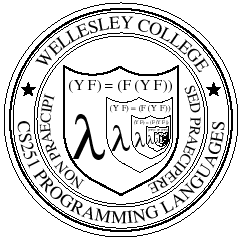
Syllabus
Course Information
Handouts
Resources
Lateness Coupon
Welcome to Programming Languages
This course studies programming languages from a language designer's point of view, by examining the fundamental elements in the design of programming languages.Even if you are not going to be a programming language designer, this information is valuable because
- Understanding how a programming language is designed and how it might be implemented will make you a more effective programmer.
- Learning a new programming language is much easier if you know the key issues in its design and can ask the right questions about it.
- Designing an API, whether it be for tools you build for others or only for yourself, is an exercise in programming language design. If your design includes configuration or extension capabilities, it really is a language design!
- It is great loads of fun!
We shall explore these central ideas, in the context of three themes that run through the course:
- Design dimensions. Programming languages can be analyzed along a number of discrete dimensions. The dimensions we will use to study programming languages include choices of first-class values, naming, state, data, control, types, safety, and memory management.
- Programming Paradigms. Programming languages can embody many different models of computation. Java is representative of the object-oriented model, while C is a popular exemplar of the imperative model. In this course, we will study four programming paradigms: function-oriented, imperative, object-oriented, and logic-oriented programming. We will read and write programs in all of these paradigms, but most of our focus will be on the function-oriented paradigm.
- Interpreters and Translators. One of the best ways to
understand the design space of programming languages is to study
the implementation of simple languages. There are two fundamental
approaches to programming language implementation:
- interpreting one programming language (the source language) on top of another (the implementation language); and
- translating a program in one programming language (the source language) into another programming language (the target language) via a translation program written in an implementation language. Reading, modifying, and building interpreters and translators are key activities in this course. We will use OCaml, Scheme, Haskell, Java, and C as the implementation languages for various ``mini'' source languages.
Interpreters and translators are excellent examples of
meta-programming, in which programs manipulate other
programs. The notion of meta-programming may seem confusing and
somewhat incestuous at first glance, but many computer scientists
consider meta-programming to be the most interesting kind of
programming activity. We will get lots of hands-on experience
with meta-programming this semester.
Author: Mark A. Sheldon
Last modified: 31 Dec 2005
Last modified: 31 Dec 2005